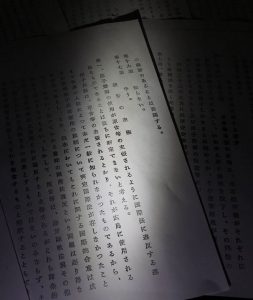Documenting Hiroshima 80 years after A-bombing: In October 1955, government’s written response in trial of atomic bombings
Mar. 20, 2025
National government argues atomic bombings were “legal”
by Kyosuke Mizukawa, Senior Staff Writer
In October 1955, preparatory procedures were underway to put together arguments in the so-called “A-Bomb Trial,” held at the Tokyo District Court, in which A-bomb sufferers from Hiroshima and Tokyo had filed a lawsuit against the national government. The question was whether or not the atomic bombings of Hiroshima and Nagasaki by the United States had been in violation of international law. The government submitted its first written response as the defendant to the plaintiffs, who were seeking compensation for damages on the grounds that the bombings had been illegal.
The lawsuit had been filed in April 1955 by a total of five plaintiffs at the Tokyo and Osaka district courts (in a case that was later combined in Tokyo). The aims of the lawsuit were to give momentum to the movement to ban atomic and hydrogen bombs and provide aid and relief to victims and sufferers of the atomic bombings.
The lawsuit was led by Shoichi Okamoto, an attorney from Ashiya City in Hyogo Prefecture who died in 1958 at the age of 66. In his booklet titled Genbaku Minso Wakumon (in English, ‘Questionnaire on civil action for atomic bomb damage’), published in 1953, he wrote, “Proving the illegality of the bombings in court should impress upon the world’s people the universal truth that the use of atomic bombs should be prohibited.”
Initially, he had planned to file a lawsuit in a U.S. court of law seeking compensation from the U.S. government and President Harry S. Truman, who was in office at the time of the atomic bombings. However, the peace agreement known as the Treaty of San Francisco, which had come into effect in April 1952, stipulated that Japan would waive its right to make claims for damages arising from the war against the Allied nations. Mr. Okamoto had asked legal professionals in the U.S. for their cooperation, but they rejected the idea, stating “there were no legal grounds” for his claims.
Waiving right to make claims
Mr. Okamoto and Tokyo attorney Yasuhiro Matsui, who died in 2008 at the age of 85, changed their plans, deciding instead to demand compensation from the Japanese government, which had waived its right to make claims from the United States. Mr. Matsui was born in present-day Mihara City, Hiroshima Prefecture, and his younger brother had been in Hiroshima at the time of the atomic bombing. He was angered at the government for “not doing anything to aid and assist A-bomb survivors,” as written in his book Senso to Kokusaiho (in English, ‘War and international law’), published in 1968.
The Atomic Bomb Survivors Association formed in Hiroshima City supported the lawsuit. Through the association, Ryuichi Shimoda and other sufferers of the atomic bombings became plaintiffs. Mr. Shimoda, who died in 1964 at the age of 65, had lost five children in the bombing.
The complaint raised in the court case emphasized the widespread destruction caused by the intense blast and thermal rays generated in the atomic bombings, as well as the cruelty of the effects of radiation on the human body. It also claimed that the indiscriminate bombing of cities, where a distinction between military and non-military targets was necessary, and the use of the “weapons that caused undue suffering” had been in violation of the Convention respecting the Laws and Customs of War on Land (Hague Convention).
However, the government’s written response issued six months after the lawsuit has been filed stated that “a determination on whether or not the atomic bombings were illegal cannot be made immediately.” It argued that because the atomic bombs were a new weapon, there were no international laws prohibiting them at the time and none at present, along with other claims. Arguing that the plaintiffs had no right to claim compensation from the United States in the first place and that the Japanese government had no obligation to provide compensation, the response sought dismissal of the original complaint. In his book, Mr. Matsui wrote, “I was terribly saddened and could not help feeling resentment.”
Complete about-face after occupation
The government had completely changed its stance following the war and the occupation of Japan. On August 10, 1945, four days after the atomic bombing of Hiroshima, the government had submitted a letter of protest to the United States, claiming that use of the “new type of bomb” in Hiroshima had been a violation of international law. The Japanese government condemned the indiscriminate killing of noncombatants as a “crime against human culture.”
After the government submitted its written response at the trial, the plaintiffs called into question the change. The government explained it had changed its position because it was no longer a nation at war. It also seemed to affirm the atomic bombings with the argument that the bombings had “prevented the killing and injuring of many more human lives on both sides of the belligerent nations by ending the war.” The unprecedented lawsuit involving assessment of the atomic bombings from the perspective of international law took more than four years just for the preparatory procedures, with a final ruling being handed down in December 1963.
(Originally published on March 20, 2025)








